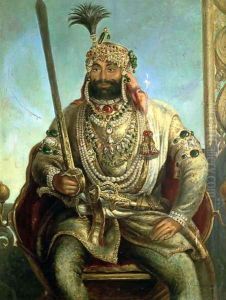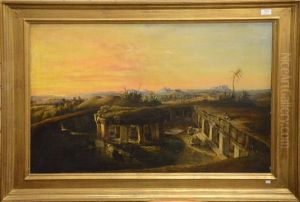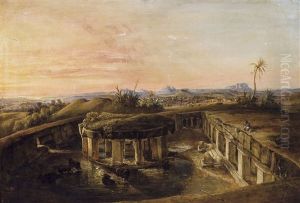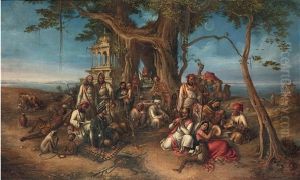August Theodor Schoefft Paintings
August Theodor Schoefft was a Hungarian painter, born on September 23, 1809, in Sopron, Hungary. He was known for his detailed and exotic paintings, particularly those that depicted Indian culture, which he became fascinated with after his extensive travels in the country. Schoefft's early career was marked by his studies at the Vienna Academy, where he honed his skills and developed a foundation that would support his later works. His deep interest in orientalism and ethnography significantly shaped his artistic trajectory, leading him to create works that were rich in cultural depiction and vibrant in color.
Schoefft's journey to India in the 1840s was a turning point in his career. He spent several years traveling across the country, immersing himself in the local culture and traditions, which deeply influenced his artistic output. His most famous work, 'The Palace of the Maharaja of Benares', stands as a testament to his meticulous attention to detail and his ability to capture the opulence and splendor of Indian palaces. Schoefft's paintings from this period are notable for their intricate detail, vivid color palette, and the sense of realism they convey, making him one of the few Western artists of the time to depict India with such depth and sensitivity.
Upon returning to Europe, Schoefft enjoyed considerable success, with his Indian paintings being highly sought after by collectors and the aristocracy. He also worked on portraits and historical scenes, showcasing his versatility as an artist. Despite his travels and the influence of other cultures on his work, Schoefft remained deeply connected to his Hungarian roots, and his contributions to Hungarian art were significant. He was recognized for his ability to blend Western artistic techniques with Eastern themes, creating a unique and captivating body of work that continues to be celebrated today.
Schoefft's legacy is that of a pioneering figure in the field of Orientalist art, and his works are preserved in various museums and private collections around the world. His death on April 13, 1888, marked the end of a prolific career, but his paintings continue to inspire and captivate audiences, serving as a bridge between the cultures he so vividly portrayed. Schoefft's dedication to exploring and documenting foreign cultures through his art has left an indelible mark on the history of 19th-century European painting, making him a key figure in the Orientalist movement.












